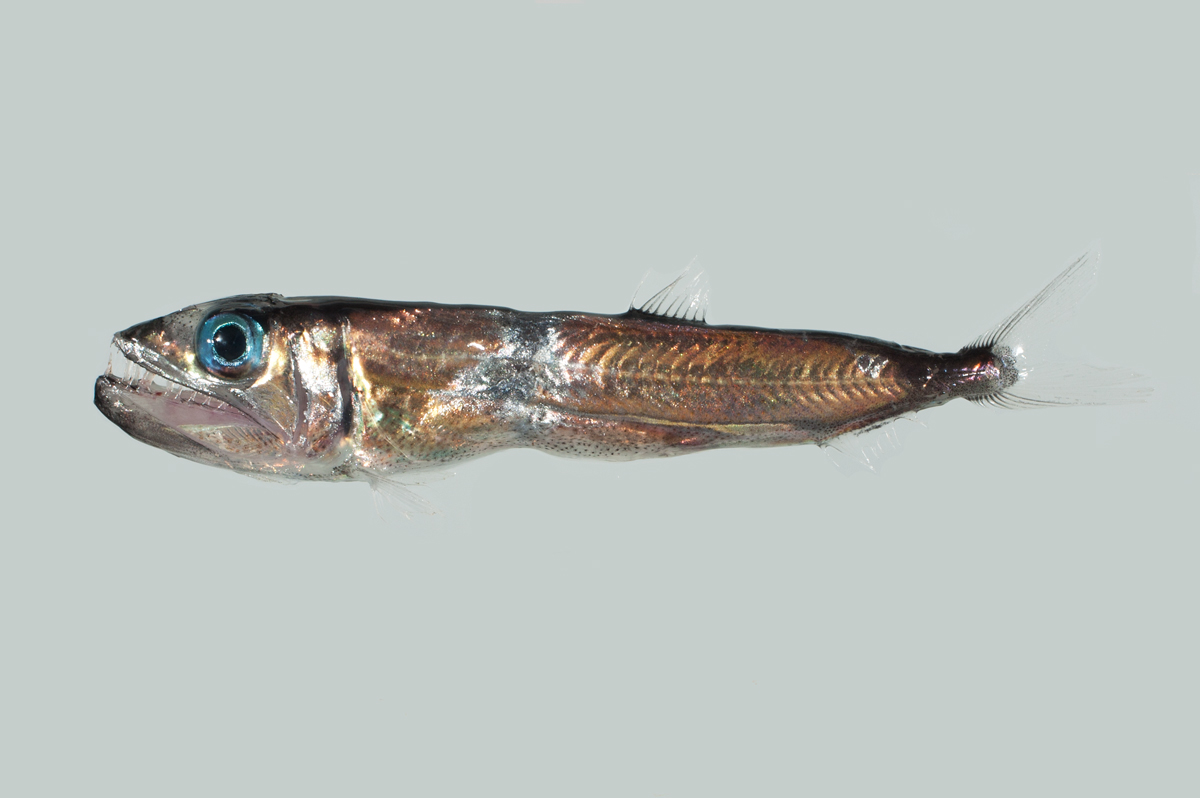Hammerjaw, Omosudis lowii Günther 1887

The Hammerjaw, Omosudis lowii, collected on the 2003 NORFANZ Expedition to the seamounts of the Tasman Sea. Source: Mark McGrouther / NORFANZ Founding Partners . License: All rights reserved
Hammerjaw, Omosudis lowii Günther 1887
More Info
|
Distribution |
Found worldwide in tropical and temperate oceans; meso- and bathypelagic at 730–4000 m. |
|
Features |
Meristic features: Dorsal-fin rays 9–11; Anal-fin rays 13–14; Caudal-fin rays 19; Pectoral-fin rays 12–13; Pelvic-fin rays 8; Lateral line absent. Head large, blunt, length 27–33% SL, front of lower jaw deep; mouth large; teeth present in jaws, palatines and pharyngeals; jaw teeth in a single row, lower jaw with huge, prominent slender canines, one of which is enlarged; upper jaw with small canines along edge, and several pairs of large, slender canines on palatines. Dorsal fin short-based, centred on back; sides of body with a lateral dermal keel on the caudal peduncle above the posterior half of the anal fin. |
|
Size |
To about 30 cm. |
|
Colour |
Iridescent, brassy-silvery, shading to black or dark brown on the back, with minute to small, brown or black spots densely scattered over the body; black stripe covering keel midlaterally on caudal peduncle; tips of snout and lower jaw and forward edges of jaw dark brown to black; dorsal, anal and caudal fins dusky to black; other fins mostly lacking pigment. |
|
Feeding |
Hammerjaws are voracious mid-water predators, feeding mostly on squid and other fishes, often taking prey items larger than themselves. |
|
Biology |
Hammerjaws are synchronous hermaphrodites, having both male and female reproductive tissue at the same time. Fertilization is external, eggs and larvae are unknown. |
|
Fisheries |
Of no interest to fisheries. |
|
Conservation |
IUCN Red List: Not evaluated. EPBC Act 1999: Not listed |
|
Remarks |
Hammerjaws are relatively rare fishes, possibly becasue they are strong swimmers and may evade capture in trawl nets. Large adult specimens are extremely rare. |
|
Similar Species |
The Hammerjaw is the only species in the genus Omosudis. |
|
Species Citation |
Omosudis lowii Günther 1887 Rept. Sci. Res. Voy. Challenger 22(57): 201, fig. 6, pl. 52(c, c'), Philippine Seas and Magdalena, Madeira. |
|
Author |
Dianne J Bray |
Hammerjaw, Omosudis lowii Günther 1887
References
Bray, D.J. 2008. Family Alepisauridae – Lancetfishes, hammerjaws. In: Gomon, M.F., D.J. Bray & R.H. Kuiter. Fishes of Australia’s Southern Coast. Reed New Holland, Chatswood, Australia.
Ege, V. 1958. Omosudis Günther, bathypelagic genus of fish. 'Dana' Reports 47: 1-19, figs 1-3.
Günther, A. 1887. Report on the deep-sea fishes collected by H. M. S. Challenger during the years 1873-76. Report on the Scientific Results of the Voyage of H. M. S. Challenger 22(57): i-lxv + 1-268, Pls. 1-66.
Maul, G.E. 1986 Omosudidae. p. 280. In Smith, M.M. & P.C. Heemstra (eds.) Smiths' sea fishes.
Nielsen, J.G. & A. Jespersen. 1986. Morphometric changes in ripening Omosudis lowei (Pisces, Omosudidae). Archiv für Fischereiwissenschaft 37: 59-67.
Paxton, J.R., D.F. Hoese & J.E. Gates. 2006. Alepidauridae (pp. 497-498). In: Beesley, P.L. & A. Wells. Zoological Catalogue of Australia. Volume 35. Fishes. Parts 1-3.
Paxton, J.R. & V.H. Niem. 1999. Omosudidae. In Carpenter, K.E. & V.H. Niem (eds). FAO Species Identification Guide for Fishery Purposes. The Living Marine Resources of the Western Central Pacific. Volume 3. Batoid fishes, chimaeras and bony fishes part 1 (Elopidae to Linophrynidae). FAO, Rome. Pp. iii-vi, 1398-2068
Rofen, R.R. 1966. Family Omosudidae. In Olsen, Y.H. (ed.) Fishes of the western North Atlantic. Memoir. Sears Foundation of Marine Research 1(5): 462-481 figs 163-172.

